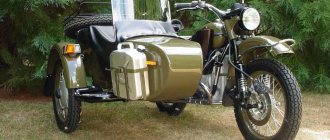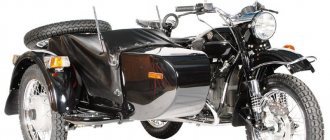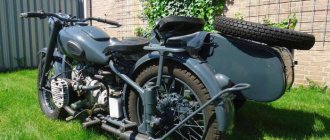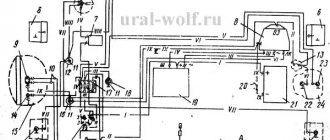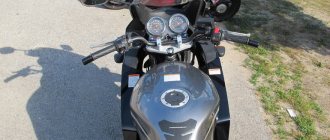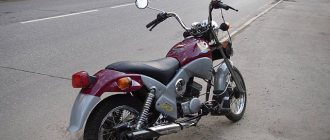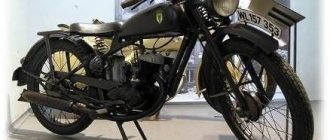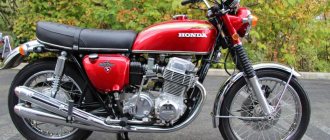The Ural Wolf IMZ-8.1238/7 motorcycle was received rather coolly by the public, who were dissatisfied with some of its shortcomings. But, hand on heart, we note that it is not always easy to be the first in anything, and this model was a real pioneer. Forget your grandfather’s “opposite” from the 80s, turned into a kind of chopper with the help of a sledgehammer and an angle grinder! Ural Wolf – real Russian chopper straight from the assembly line, with all its pros and cons. It was developed on the basis of the small-scale Ural Cobra chopper, which was distinguished by a dry suspension without rear shock absorbers and other radical solutions in the spirit of the old school. As a result, only a few copies of the Cobra were produced, but its successor went into full-fledged mass production.
Design
Classics are always in trend. The Wolf looks like a kind of hybrid of a Ural and a Harley-Davidson, but in a good way. This bike does not look like a garage handicraft made by collective farm craftsmen, and it really looks stylish. The impressions are spoiled only by the ugly wires hanging on the steering wheel and the shamelessly exposed cardan, but these moments can be eliminated on your own.
Specifications
Built using technologies that were outdated decades ago, the Ural Wolf lacks stars from the sky. But in Russia and the CIS countries there are enough connoisseurs of “opposite” motorcycles, for whom this motorcycle is primarily designed.
Engine
The 750 cc 2-cylinder engine can be called a real rarity. It is a file-modified version of an ancient engine from 60 years ago, and therefore produces only 45 hp. The dynamics of the bike are mediocre, but the engine is still capable of pleasing. Pleasant exhaust sound, light vibrations of a “real iron motorcycle” and impressive traction at low revs - lovers of cruisers will like all this .
Transmission
The Ural Volk gearbox is almost no different from the one that was installed on Soviet “opposite” cars half a century ago. It only has 4 steps , and the fifth is noticeably missing. But you can engage fourth at 60 km/h, and then drive like an automatic transmission. In addition, the gearbox is one of the few components of a bike with which problems almost never arise.
Chassis and brakes
The entire structure described above is embedded in a steel frame made of welded pipes, which is quite short by cruiser standards. Thanks to this, the bike handles well, but it weighs a lot. The suspension, however, let us down, especially the front fork, which is too weak for the tenacious Brembo front disc brake . At the rear there are two standard shock absorbers “a la” a candle, hard and generally practically useless. On uneven asphalt, the biker is guaranteed to feel every bump with his butt. Let’s tactfully keep silent about the rear brakes - you shouldn’t expect much from the archaic “drum”. Let us just note that most Japanese cruisers of those years also had weak drum brakes at the rear.
Electronics
Everything is simple, like in some Soviet “opposite”. True, the Ural Wolf received many imported components, from the battery to the modern microprocessor ignition (here all experienced boxers should breathe a sigh of relief - meticulous adjustment of the ignition angle is a thing of the past). The wires, however, are laid out somehow, but in general there are no complaints about the quality of the electronic filling.
Weight and dimensions
The dry weight of the Ural Wolf reaches 249 kg . This is not much by cruiser standards, but noticeably more than that of foreign analogues comparable to it in terms of technical characteristics. And this weight is almost not felt due to the fact that the lion's share of it falls on the low-mounted motor. In the parking lot, handling the bike will not be difficult even for a puny motorcyclist.
Controllability
The Ural Wolf handles just like any other chopper, that is, mediocre. Although, thanks to the short wheelbase, its maneuverability is still quite good. At the same time, the base is not so short as to prevent it from confidently holding course on the highway. This model is designed for highways , not narrow streets, and once released, the Wolf feels like a duck to water.
Fuel consumption
The motorcycle consumes AI-92, and consumption starts from 5-5.5 liters . It is not too demanding on the quality of gasoline, and will probably run smoothly even on AI-80. But when driving on the highway at a speed close to the maximum, the consumption almost doubles.
Features and Design
The characteristic features of Russian units are almost completely removed from this model. The bike has a “spread out” shape due to the long base.
The distance between the front and rear axle is 1690 mm.
Given its weight, the motorcycle is set low, which increases its maneuverability parameters.
You can also mention the high-quality steering system, which uses Italian bearings with tapered angular contact rollers.
Thanks to its design, the “Wolf” is suitable not only for highways, but also for comfortable movement around the city.
External parameters of the bike: length – 2.53 m; width – 0.85 m, height – 1.3 m.
The weight of the “naked” motorcycle is 249 kg. In comparison with other motorcycles in the post-Soviet space, the Ural Wolf does not differ much in external characteristics from Western choppers.
There is an abundance of chrome, leather, and a very solid, brutal appearance .
A motorcycle worthy of your attention is the Honda Hornet 600, which has excellent characteristics.
Dedicate a weekend to riding through the forest, doing housework or even participating in races - with this motorcycle from Honda, it is more than possible.
Repair and tuning
95% of Volk owners, former and current, bought it having already had experience driving Soviet boxer cars. And such a public cannot be frightened by technical problems! These people are able to assemble a vertical take-off submarine from the ancient Izh if you give them a penknife, pliers and a hammer.
Repair
Maintainability is the strong point of this motorcycle. It can be disassembled, reassembled, disassembled again, and so on until you get tired of it, or until the problem is fixed. But purely technically, it is not capable of breaking so much that it cannot be repaired on its own.
Spare parts
This is the main headache for the owners of the Ural Wolf. Many spare parts for it are unique, and analogues from other models are not suitable. At the same time, original parts for the Wolf have not been produced for a long time, and it is very difficult to find them on sale. And due to the low popularity of the model, non-original ones are almost absent.
Tuning
Each owner customizes the bike in his own way. Someone hangs panniers and installs glass, someone alters the seats and decorates the steering wheel with leather pads, someone tries to squeeze more power out of the engine... But all this tuning costs money, and the best way to use it would be to sell the Urals and then buy some kind of either a Honda or a Yamaha.
Motorcycle modifications
There is only one version of the Ural Wolf motorcycle. Over the course of ten years of production, it underwent several small upgrades that eliminated a number of “childhood sores,” but overall the bike remained the same. The designers took into account their own experience, and less old copies have fewer problems, so when buying it is better to choose a more recent option.
Ural motorcycle gearbox gear ratios
MOTORCYCLE GEARBOX “URAL”, “DNEPR”
On motorcycles “Ural” and “Dnepr” K-650 a two-way four-speed gearbox model 6204 is installed. On motorcycles “Dnepr” MT9, MT10-36, MV-750M MV-650, “Dnepr-12” a two-shaft four-speed gearbox with reverse gear is installed and an automatic clutch release mechanism of the MT804 model.
All models of road motorcycle gearboxes have constant gear ratios in all four forward gears: 1 - 3.6 (36/10), 2 - 2.28 (32/14), 3-1.7 (29/17) , 4-1.3 (26/20). The gear ratio is obtained by dividing the number of teeth of the driven gear (secondary shaft) by the number of teeth of the drive gear of the primary shaft.
GEARBOX OF MOTORCYCLES “URAL”, K-750 AND K-750M
The gearboxes of the Ural and K-750, K-750M, K-650 motorcycles (Fig. 4.9) of the Kyiv Motorcycle Plant are unified. Since 1980, modernized gearboxes began to be installed on Ural and Dnepr motorcycles. The cam clutches on the secondary shaft were replaced with splined ones, the external parts of the gear shift mechanism were changed into a closed crankcase cavity and isolated from dirt getting on the working surfaces. Replacing claw clutches with splined ones has significantly reduced the possibility of self-disengaging gears. Placing all parts of the switching mechanism in closed cavities significantly reduced their wear, increased the reliability and durability of the mechanism. New models of Ural motorcycle gearboxes are created on the basis of previously existing ones through repeated modernization. The gearbox model with reverse gear, produced since 1987, has much in common with the previous one.
The gearbox housing consists of: crankcase 3, front covers 1, left 11 (Fig. 4.9) and right 19 (Fig. 4.10). The crankcase and front cover are load-bearing parts that absorb the main loads during operation of the gearbox. They contain shaft supports. The left and right covers are attached to the crankcase, on which the gear shift mechanism is mounted.
Advantages and disadvantages
Many of us started with Soviet motorcycles, which helped us develop skills not only in riding, but also in repair. The Ural Wolf is not far behind its predecessors in this regard, and you have to tinker with it quite a lot. Unless, of course, you actually ride a motorcycle and don't just store it in the garage. But can such difficulties scare an experienced oppositionist?
Advantages
- Powerful low-end traction. In urban conditions, the bike has enough power, and it feels quite confident in traffic.
- Stylish appearance . Looking at it, it’s hard to believe that this is a domestically produced motorcycle.
- Spacious 21 liter gas tank. The power reserve when driving slowly at 100-110 km/h reaches 400 kilometers.
- Reliability of some important components. Ducati ignition, Brembo front brakes, Denso generator – the Wolf has plenty of imported components.
- The center of mass is shifted downwards , making the motorcycle subjectively seem light.
Flaws
- Weak acceleration dynamics . From 0 to 100 km/h the motorcycle accelerates in about 10 seconds, lagging even behind Japanese 400 cc cruisers. If you are patient and turn the throttle towards yourself, after some time you can see 150 km/h on the speedometer.
- Low reliability . Reviews from owners of the Ural Wolf motorcycle are full of descriptions of all sorts of problems that they had to face.
- Mediocre ergonomics . Long-legged motorcyclists will find this model uncomfortable and cramped.
- Difficulty finding spare parts , especially those purchased by the Irbit plant abroad.
- Weak front fork , not designed for hard braking, and therefore poorly combined with Brembo brakes.
Checkpoint Ural or Dnepr?
Please tell me. I want to install a new gearbox. Experienced men in the market said that 1) the Ural gearbox with reverse gear is “raw” and basically unfinished by the manufacturer. 2) The Dnepr gearbox is originally with reverse gear and is made better and more reliable. It is also faster. Who thinks which is better, the Ural or the Dnieper? Is the checkpoint from the Dnieper installed in the Urals one to one in a regular place? Thanks in advance
Nenad has nothing to file, the box stands up normally, you can only try to file the cardan, or, as was said above, install the Dnieper box together with the cardan. IMHO the Dnieper box is still better!
about working with a file: it’s probably different on different models and years :) it’s still decided according to the location.
The gear ratios are the same in the Urals and the Dnieper. The Dnieper box mega-rules nevertheless.
The dneprocorb definitely works better!
Ural Korobas has not changed since BMW times, only in appearance
A drip box is definitely needed. And the crankcase will have to be slightly modified on one eye of attachment to the frame. The cardan is shorter and the original clutch cable is needed ideally.
Right now I’m bothering with installing a drip box on 8.103.10. So, although everyone says it’s easy, the bottom box fits into my frame, but there’s no room left for the coupling(((You don’t have to file the eyelet. Anyway, to install the box I had to unscrew the top engine mount and pull out the front pin engine mounts. Now I machined the Dneprocardan rear fork on a machine and ground off the coupling rubber 3 mm on each side. I gained about 1 cm. I'll go experiment. The bike was produced in 1994, and along the way, the frame sizes are still different for everyone. The costs of the domestic motorcycle industry are so say. And you yourself know the quality of the parts. One shoulder of the rear fork is machined 4 mm less than the other.
In short, it's a kick-ass. Nothing succeeded. Since there is no desire to digest the engine mount, I will install a Ural gearbox (((
Who needs a drip box? (((
I like the Ural Box. everyone is satisfied. Over the years there has been virtually no wear and tear (1984), but I plan to install a Dneprokorobka. because It is possible to put 5th gear. )))
I tore the second gear gear on my Ural gearbox 3 (THREE) times. And on the asphalt. Either the quality of the gears was bad or who knows.
Is your gearbox completely attached to the engine? Often, without sharpening the left rear ear of the Ural engine, the MT gearbox is not completely docked to the engine. In one book, when installing the MT-804 gearbox on early model motorcycles, if the fork gets caught on the frame, it is recommended to slightly sharpen the pendulum mounting unit at the point of engagement. Book "Motorcycles Ural, Dnepr".
The link to download this book is in the topic “Instructions for the Dnepr checkpoint” page 97. Fig. 4.13
Is your gearbox completely attached to the engine? Often, without sharpening the left rear ear of the Ural engine, the MT gearbox is not completely docked to the engine.
Fully. I had to sharpen it when I installed it without moving the engine forward.
Then the sander is in your hands and just like in the book.
In other respects, Dnieper is better.
On the Dnieper, between the 1st and 2nd and between the 3rd and 4th, the fishing is much clearer than on the Ural.
I also had it on M67. Now I have 8.103
For reference: The length of the Dnieper box is 20 cm, the box in the Urals is M66 19 cm, in the Urals M67 is 18 cm. As a result, we get two types of valves for the Urals: a large spline for M66 and a small spline for M67. The difference between the cardans is 1cm, respectively. those. with a small slot longer. The frames of the Dnieper and the Urals seem to be the same in theory.
As for comparing gearboxes. Uralovsk boxes are usually shitted by those who have traveled on the Dnieper. And those who are accustomed to the Ural ones catch netral with their feet with the same ease as on the Dnieper ones. And if you take a Ural gearbox with reverse gear, there are two knobs, one shifts all gears. and the other switches the reverse. Moreover, you can engage the rear in neutral or in 1st gear, by returning the handle back you will immediately get neutral.
On the Dnieper you can only turn on the rear from the neutral. You have to catch it first.
Source
Owner reviews
Only hardened oppositionists and those who are not afraid to get their hands dirty should buy. It looks decent in the photo, but that's just the photo. This monster requires attention after every trip, and if you come to the garage in the morning and don’t find traces of oil drops under it, it means that the oil leaked out even before the bike drove into the garage. It makes sense to hang trunks to carry a set of tools and a lighter. The lighter will come in handy if the Urley-Dneperson breaks down completely at some point, and it will be easier to burn it than to drag it home. Artyom, Novosibirsk.
In direct and caring hands, the bike is very reliable! No match for the old oppositionists of the shaggy years. The mileage has already exceeded 40,000 km (I took it with a mileage of approximately 10,000), there were no serious problems, although you need to use your hands from time to time. A good option to learn how to both drive and repair your equipment. No matter how much I drive, I still have no desire to change, although there is a possibility. Sergey, Miass.
The bike is not perfect, but not bad. Yes, it requires attention from time to time, but this moped can be inherited by grandchildren. It is repaired with a screwdriver and pliers, and repaired in an open field on the knee. There are enough dynamics, whoever wants to race buys a sport, not a chopper. Evgeniy, Anapa.
Messages [from 21 to 40 of 55]
21↑ Reply from pet.mikh.mikh 08/17/2014 17:33:14
Re: Help me identify the box
Waiting for you.
22↑ Reply from work 08/18/2014 15:34:48
Re: Help me identify the box
I have a box that is assembled in the housing through hatches. Where can I read about the assembly nuances? I saw a video on the forum of assembling a box with a lid, but I have something very early.
Edited by work (18-08-2014 16:35:46)
23↑ Reply from Luis 08/18/2014 15:48:31
Re: Help me identify the box
And the Shaman “threw a fishing rod”
24↑ Reply from drakone 08/18/2014 16:11:07
Re: Help me identify the box
25↑ Reply from mexanik62 08/18/2014 16:43:20
Re: Help me identify the box
I have a box that is assembled in the housing through hatches. Where can I read about the assembly nuances? I saw a video on the forum of assembling a box with a lid, but I have something very early. I don't know how to post photos?
Edited by mexanik62 (18-08-2014 16:43:38)
26↑ Reply from work 08/18/2014 16:59:06
Re: Help me identify the box
It looks like a showdown. Even in early childhood, I beat everyone in disassembling everything, but I have a problem with assembly. Whose box is this, what is its name, what should I look for?
Edited by work (18-08-2014 17:00:42)
27↑ Reply from mexanik62 08/18/2014 20:51:53
Re: Help me identify the box
If the shift drive (rocker) is outside, then it is an M72 gearbox. And if under the cover then K750, K650, M63. Reassemble in reverse order. Kotov’s book says how.
28↑ Reply from shaman507 08/18/2014 21:58:26
Re: Help me identify the box
And the Shaman “threw a fishing rod”
I didn’t throw anything)). I haven’t even disassembled one of these boxes, much less assembled them, although I have about six of them. And I’m unlikely to bet. I like the Dnieper ones.
29↑ Reply from work 08/18/2014 22:59:58
Re: Help me identify the box
If the shift drive (rocker) is outside, then it is an M72 gearbox. And if under the cover then K750, K650, M63. Reassemble in reverse order. Kotov’s book says how.
Edited by work (18-08-2014 23:03:43)
30↑ Reply from mexanik62 08/19/2014 06:17:23
Re: Help me identify the box
31↑ Reply from shaman507 08/19/2014 08:37:49
Re: Help me identify the box
mexanik62 I have almost all models of boxes. The literature mentions the Dnieper without reverse speed. What does she look like maybe you've met? Or is this a box with lids like in the topic?
Toha where are the photos of the boxes?
Here is a photo of the boxes. The top row is arranged by year of production (from left to right) starting with the M-72 box and ending with the Ural one with reverse speed.
Bottom row Dnieper two types.
Edited by shaman507 (19-08-2014 09:03:23)
32↑ Reply from work 08/19/2014 09:34:27
Re: Help me identify the box
33↑ Reply from mexanik62 08/19/2014 16:00:12
Re: Help me identify the box
mexanik62 I have almost all models of boxes. The literature mentions the Dnieper without reverse speed. What does she look like maybe you've met? Or is this a box with lids like in the topic?
Here is a photo of the boxes. The top row is arranged by year of production (from left to right) starting with the M-72 box and ending with the Ural one with reverse speed.
Bottom row Dnieper two types.
1. M72, M72N, M72M, M61, M62 2. M63, K750, K750M, K650, MV750 3. M66 4. M67, M67-36, IMZ 8.103 5. IMZ 8.103 and younger 6. Dnepr 11, Dnepr 16 and younger 7. MT9. MT10, MT10-36, MT11, MV650, MV650M, Dnepr12
Edited by mexanik62 (19-08-2014 16:03:56)
Source
Similar models
- Yamaha XVS 400 Drag Star. In terms of technical characteristics and price on the secondary market, it approximately corresponds to the brainchild of the Irbit plant.
- Honda Steed 400. Another extremely popular light cruiser, reliable and durable.
- Suzuki VS 400 Intruder . A motorcycle proven over hundreds of thousands of kilometers and tens of thousands of owners.
FAQ
- Are spare parts from old boxer cars suitable for it? Basically no, most of the components and parts from old IMZ motorcycles will not fit.
- How common are breakdowns? Is it possible to take a risk and travel 3-5 thousand km? You can take a risk, but most owners would hardly advise doing so, based on their own experience. Breakdowns, alas, happen more often than we would like.
- The heat from the cylinders actually fries your legs. What can be done about this? Nothing if you don't move the pegs. This bike has earned the nickname “Heel Eater” for a reason.
Conclusion
This bike was a test of the strength of the Irbit Motor Plant, and this test should be considered successful. It’s only a pity that the designers decided to curtail production instead of carrying out extensive work on bugs and offering customers an updated model that could compete with foreign motorcycles, if not due to quality, then at least due to price.
Specifications
| Maximum engine power: | 45 HP |
| Working volume: | 749 cm3 |
| Motor type (cylinder arrangement, number of strokes): | Opposed twin cylinder |
| Number of cylinders: | 2 |
| Number of valves: | |
| Intake type (Injector / Carburetor): | |
| Bore and stroke: | |
| Starting system (Electric starter, kick starter): | |
| Maximum speed in km/h: | 150 km/h |
| Cooling system: | Air |
| Transmission (gearbox): | 4-speed |
| Clutch (Dry / Wet): | |
| Drive unit: | Cardan |
| Frame: | Closed steel frame, duplex |
| Chassis | |
| Suspension (front/rear travel): | |
| Brakes (Front/Rear): | |
| Wheels / Tires / Rubber: | |
| Dimensions and weight | |
| Dimensions (Length / Width): | |
| Seat height: | |
| Ground clearance: | |
| Curb weight: | |
| Wheelbase: | 1690 mm |
| Weight: | 249 kg |
| Fuel tank capacity: | 21 l. |
| Battery capacity: | |
| Year of release: | |
| Country of Origin: |
History of the development of the legendary Ural motorcycles
Ural motorcycles are manufactured in the Sverdlovsk region at the Irbit motorcycle plant. The story began in 1941, when it was decided to evacuate the Moscow Motorcycle Plant to Irbit. Production was located in the workshops of a former brewery, and already in 1942 the first batch of the famous M-72, which were developed in Moscow, was produced. This model was produced until 1961. Having begun during the war, production was focused exclusively on the army, and in the post-war years the M-72 began to be produced for the needs of the national economy.
In 1957, designers developed a new machine, the M-61. It was not produced for long, its production ended after 4 years. But for the developers, the modification was of great importance. The M-61 was a transitional model, and in 1961 a new bike, the M-62, appeared, which was called the Ural. It was already very different from its famous progenitor M-72. The new one received a more powerful engine, a completely new gearbox and a significantly redesigned chassis.
© Alexey Gusev / Photobank Lori
Subsequently, three-wheelers underwent more than one change. Being the only one in the country producing heavy motorcycles. The Irbit Motorcycle Plant successfully sold its models on the domestic market and for export. Designers constantly worked to improve the design and improve speed characteristics. The last motorcycle of the Soviet period was the IMZ model - 8.103-30.
The story didn't end there. The plant itself was repeatedly renamed and declared bankrupt. But production survived, and today Russian heavy motorcycles are in fairly high demand. True, sales markets are now mainly located abroad. In the USA, Europe and Canada, high-quality motorcycles from the Irbit Motor Plant are highly valued. In recent years, more and more bikes are being sold on the Chinese market and in the Middle Eastern countries. New supermodels are also popular in their homeland.
Return to contents — ↑


